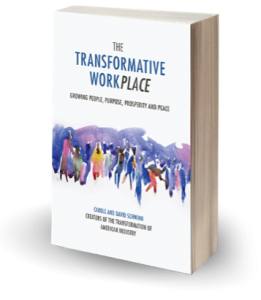Reviewed by Matt Dockerty for Enlivening Edge
The Transformative Workplace: growing people, purpose, prosperity and peace
From inside the book cover: “Other authors have written about enlightened or conscious organizations. They have eloquently spoken to what leaders in those organizations must do, how their policies and procedures are different, how their visions and values contribute to their character, and how these differences impact their performance in the marketplace.
The Transformative Workplace stands out because it also shows how people themselves can be different, and how these differences positively affect their own lives, the lives of their families, their workplaces, their communities, and the wider society.”
Carole and David Schwinn’s The Transformative Workplace offers beautiful examples, principles, and practices for people and organizations aspiring to reach their highest potential as conscious humans. The book is highly effective at connecting real people and communities to principles and evidence of higher consciousness, and to the transformative outcomes that result.
Providing comprehensive and relevant examples, the book compellingly supports its argument that “expanding the consciousness of people enlarges the purpose of the organization, leads to prosperity and, ultimately, creates greater possibility of a more peaceful world.”
Carole and David take us on a journey across the globe, sharing poignant and engaging stories of spirited people making a positive difference in the world – stories that inspire us to be active and conscious participants for positive change. I was delighted to find such a deep, conscientious exploration, with examples from all continents, contexts, and viewpoints expressed and beautifully synthesized.
The book is organized around themes of 1) Selfness, 2) Otherness, and 3) Wholeness, and there are strong resonances throughout with the three tenets of Teal organizations as described by Frederic Laloux’s Reinventing Organizations. Each theme holds the central enquiry of the work: diligently exploring how workplaces can support and inspire the unfolding and growth of “who we were meant to be as human beings.”
Each chapter begins with an example of people and workplaces exhibiting conscious practices and beliefs. From these examples, the authors highlight principles (diligently linked to relevant literature and theory) and then offer practices or insights to enable higher consciousness in workplaces.
As such, the practice of wholeness itself feels manifest throughout the book as the authors connect us through heart, experiences and theory – echoing the meta-principle of the book. The style of writing and exploration itself felt very congruent with the book’s message and intention, and felt deeply human.
The ‘Selfness’ theme explores meaning across levels of context and consciousness. I personally found this invigorating: given the constant, and sometimes tiresome, exhortation of many coaches recently for us to find our absolute and only true purpose! This work is more subtle and insightful in its exploration of purpose: realizing that purpose or meaning are not static, but evolve dependent on the context, and are grounded in reality – wisely considering purpose within the contexts of survival consciousness through to transformation, and of human evolution and needs.
The excerpt “There is nothing more essential to transformative growth than challenging our own deeply held-beliefs and assumptions” sums up the authors’ enquiry into challenging assumptions. This and the ‘Attending to well being’ chapter provide expert and practical advice on encouraging and holding organizational learning environments to promote such transformation.
The last chapter in the ‘Selfness’ theme – ‘Acting Autonomously’ – resonates strongly with Laloux’s self-management aspect of Teal organizations: evidencing power within, rather than power over as the directing dynamic. The company evidenced, Morningstar, exhibits many of the traits and practices of companies like FAVI and Buurtzorg studied by Laloux.
In exploring ‘Otherness’, the authors advocate feedback loops as a key component for transformation, and then offer approaches for reflective practices. Whilst the inner reflection enquiry mirrored the best of thinking today, it was the chapter on ‘Appreciating beauty’, which for me, set this section apart from other books in this field.
I found this wonderful to read, and appreciated the authors’ courage to bring this forward, and model the principles as explored in the book. The linkage made between beauty and social harmony, reminded me of an association the late priest, poet and philosopher John O’Donahue made between beauty and humans’ ability to sustain gentleness and connection.
Carol and David bring to light splendid examples of companies like Oleana which hold this view and understand the importance and centrality of beauty to human experience. The chapter ends with the lament that we don’t appreciate beauty enough, and calls for presence and containers to amplify this.
Throughout this theme, the authors take us on a trip around the globe with examples of companies from India to the USA who are consciously manifesting intention, covering multiple domains from agriculture to music. The authors implore us to trust in collective intentions – as extolled by Teal organizations – and demonstrate that they are artists themselves, manifesting their will for beauty, and weaving relevant opinion and sound bites into the book material!
Considering ‘Wholeness,’ the authors start with a chapter on ‘embodying compassion’. Again, both the reader’s heart and head are engaged and there are continued learnings from cultures across the world. Revealed more explicitly is the need to amplify and draw attention to best practices and examples of humanity across the planet – a planet that the authors are so clearly compassionate about and wish to honour.
Within this theme, the book starts to explore cultural and organizational shadow, and how next level organizations are inviting all aspects of lives into the workplace – including suffering and pain.
I was pleased to see the chapter title ‘Being Peace,’ and this is one area of the book I would like to have seen developed more. As the authors themselves highlight, however, examples are harder to come by here. This chapter focused on the Rasur International Foundation, and Buddhism, asking why more examples are not forthcoming, and suggesting that this lack is a reflection of the state of current workplaces.
Closing out, the reader is asked to consider where the book draws him or her, and where there is energy for them across the themes – as a guideline for making their own work more purposeful, prosperous and peaceful. As such, organizations and people wishing to reach their highest potential as human beings in the workplace would both appreciate this book and benefit from the learnings within.
Transformational leadership calls for us to remake our workplace selves, and by putting humanity at its center, the book is a guide for those wanting to amplify such transformation. Inspiring and thought-provoking, The Transformative Workplace enhances our understanding of how spirit and humanity can be invited into the workplace to transform both the people within, and the planet we are part of. Continue to be inspired at www.transformativeworkplace.com.
 Matt lives to inspire and help people to imagine and co-create a world which facilitates the realization of humanity’s greatest potential. He is passionate about the intersection of technology and cultural and service transformation.
Matt lives to inspire and help people to imagine and co-create a world which facilitates the realization of humanity’s greatest potential. He is passionate about the intersection of technology and cultural and service transformation.





